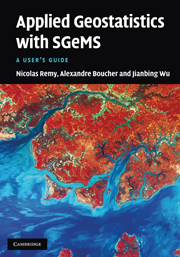Book contents
- Frontmatter
- Contents
- Foreword by Albert Tarantola
- Preface
- List of programs
- List of symbols
- 1 Introduction
- 2 General overview
- 3 Geostatistics: a recall of concepts
- 4 Data sets and SGeMS EDA tools
- 5 Variogram computation and modeling
- 6 Common parameter input interfaces
- 7 Estimation algorithms
- 8 Stochastic simulation algorithms
- 9 Utilities
- 10 Scripting, commands and plug-ins
- Bibliography
- Index
9 - Utilities
Published online by Cambridge University Press: 05 November 2011
- Frontmatter
- Contents
- Foreword by Albert Tarantola
- Preface
- List of programs
- List of symbols
- 1 Introduction
- 2 General overview
- 3 Geostatistics: a recall of concepts
- 4 Data sets and SGeMS EDA tools
- 5 Variogram computation and modeling
- 6 Common parameter input interfaces
- 7 Estimation algorithms
- 8 Stochastic simulation algorithms
- 9 Utilities
- 10 Scripting, commands and plug-ins
- Bibliography
- Index
Summary
This chapter presents service algorithms helpful in many geostatistical studies. The first algorithm is the histogram transformation TRANS. Program TRANS in Section 9.1 allows the transforming of any histogram into any other histogram by matching their quantiles. The second algorithm (Section 9.2) is a proportion transformation appropriate for categorical variables. Program TRANSCAT not only matches target proportions but also preserves the image structures. The third algorithm is POSTKRIGING (Section 9.3) which extracts useful information from kriging or indicator kriging maps. Program POSTSIM (Section 9.4) performs the same tasks but on a set of stochastic realizations resulting from any of the simulation algorithms presented in Chapter 8. Section 9.5 presents algorithm NU-TAU MODEL related to the nu/tau model, see Section 3.10: this algorithm allows the combining of different probabilities stored as properties. Section 9.6 presents utility program BCOVAR, which allows the user to calculate the covariance map between any point or block, and the covariance value between any points or blocks. Section 9.7 presents program IMAGE PROCESSING, used to perform scaling and rotation on a Cartesian grid. These operations are particularly useful for preparing a training image. MOVING WINDOW in Section 9.8 calculates local statistics such as moving average, moving variance, the default FILTERSIM filters, a Gaussian low pass filter and the Sobel filter for edge detection; it also accepts user-defined filters. Finally, a training image generator TIGENERATOR is presented in Section 9.9.
- Type
- Chapter
- Information
- Applied Geostatistics with SGeMSA User's Guide, pp. 215 - 244Publisher: Cambridge University PressPrint publication year: 2009

